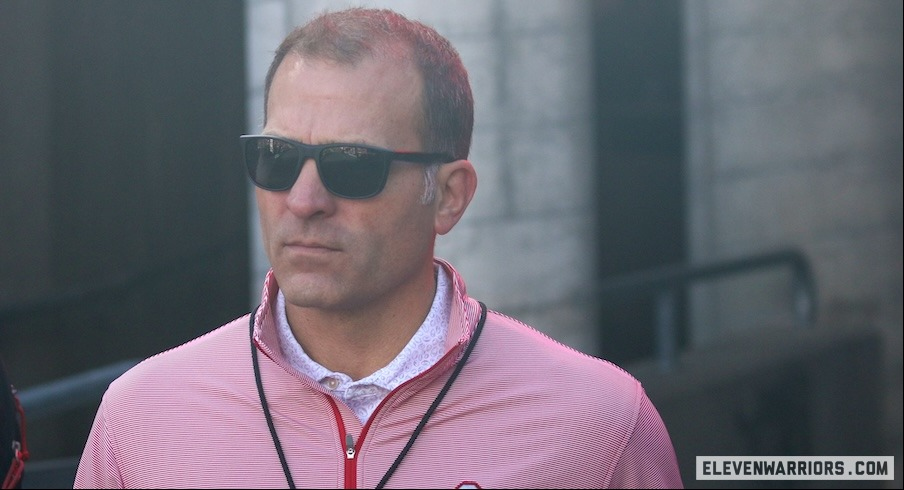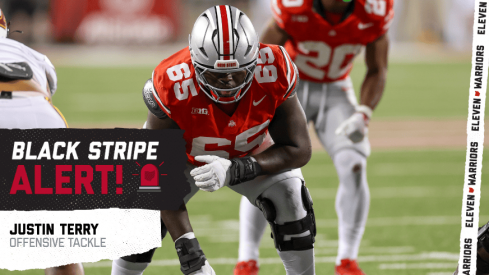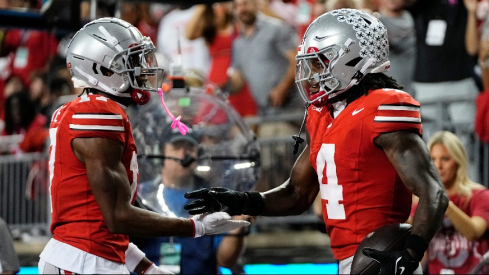More than a month after the start of revenue sharing in college sports, Ohio State and Ross Bjork are still seeking clarity on how schools are allowed to use NIL in recruiting under the new model.
All schools that opted into the House v. NCAA settlement are allowed to share up to $20.5 million in direct revenue with their athletes. Ohio State is sharing $18 million of that money with football, men’s and women’s basketball and women’s volleyball players, with the other $2.5 million funding the 91 new scholarships Ohio State added across its 36 sports.
What remains in dispute is whether schools are allowed to arrange third-party NIL deals for their athletes without counting those deals against the cap, as well as when schools are allowed to make financial promises to recruits. As those rules and how they’ll be enforced remain murky, Ohio State is taking a more cautious approach than some of its counterparts.
After initially declaring that athletes could no longer make NIL deals with university-affiliated collectives, the College Sports Commission revised its guidance last week, allowing deals with collectives but stipulating that those deals must have a “valid business purpose.” Bjork says Ohio State is operating within those guidelines right now through the Buckeye Sports Group, its in-house arm for arranging NIL deals for athletes. But OSU is eager for clearer rules and enforcement that makes everyone play by those rules.
“We have all kinds of opportunities in the business world that meet valid business purpose, range of compensation. So we're deploying those things right now,” Bjork said Tuesday. “We were ready to pivot if we needed to, but in a lot of ways, we didn't have to. That's why we created Buckeye Sports Group. We're talking to sponsors, we're talking to donors. Our collectives are still engaged from a leadership and a structure standpoint. So we have a lot of things in place to adapt to what was said last week. But also, we're still waiting on the rules to be published. We're still waiting on what does cap circumvention mean? What can and can't you do with high school prospects? Because many people have different interpretations of that world, right?
“So there's still some things that the world is waiting on for college athletics. Hopefully, we'll have some clarity this week. That's what we've been told. But we really need a whole messaging campaign to come out of the College Sports Commission. Here's our staff plan, here's the roadmap, here's the things that haven't been solved yet, but here's the things that will be solved. We've got to instill confidence in the system. And we're urging the leaders of College Sports Commission and our commissioners to get the clarity that we all need, so then we can keep marching forward.”
During an appearance on WOSU’s All Sides on Wednesday, Bjork said he believes federal legislation is also needed to regulate NIL.
“We still have state-by-state laws that are on the books that may conflict with the House case outcome. The only place that can solve that is the federal government. Like it or not, we need federal legislation,” Bjork said. “In order to really, really codify college athletics and have uniform standards in all 50 states, we need a federal law to be implemented.”
While Ohio State used to have two separate collectives – The 1870 Society and The Foundation – which arranged NIL deals for players separately from the athletic department, those collectives are now a part of the Buckeye Sports Group, which was formed in June ahead of the July 1 start to revenue sharing. Bjork said that does not change with last week’s revised guidance from the CSC and that Learfield’s Ohio State Sports Properties – which oversees Buckeye Sports Group – is hiring four more people to run the agency and source agreements between athletes and companies.
“It has to be an integrated approach now,” Ohio State’s athletic director said Tuesday. “We've been on the same page, definitely since I got here, but also even before with collectives and our team here in athletics. So even more so, a more integrated approach, I think, is needed in this environment.
“The leadership (from the former collectives) is still there. The people are still there. The infrastructure that they had in place before is still there. That never went away. How that weaves in, those are the things that are all evolving on a kind of daily, hourly basis.”
Is Ohio State being too cautious in recruiting?
Ohio State’s approach to NIL and revenue sharing has drawn scrutiny from Buckeye fans – particularly those who follow football recruiting closely – over the past couple of months. While Ohio State landed commitments from nine players in June and July, only one of them came from a player currently ranked within the top 100 prospects in 247Sports’ composite rankings for the 2026 class (Cincere Johnson). As a result, Ohio State is currently only ninth in the team rankings for the 2026 class, which would be Ohio State’s lowest ranking for a class since 2019, a year in which it signed just 17 high school recruits.
Ryan Day has stressed that he wants to recruit players “who want to be at Ohio State,” rather than players who are simply looking for the most money, so the Buckeyes have been hesitant to enter straight bidding wars for players. Ohio State doesn’t want to pay unproven high school players more than the players on its roster who have already established themselves as key contributors, and its strategy to prioritize roster retention and the transfer portal rather than overpaying recruits led to a national championship last season.
That said, it isn’t the first time Ohio State has been more cautious than its peers with using NIL in recruiting. When NIL was first introduced in 2021, Ohio State – then under the leadership of longtime athletic director Gene Smith – was hesitant to use NIL as a recruiting inducement since it was still supposed to be prohibited by NCAA rules. Eventually, Ohio State became more aggressive with using NIL in recruiting as it became clear the NCAA wasn’t going to enforce rules against offering NIL deals to prospects.
Now, Ohio State finds itself at a similar crossroads of trying to be as competitive as possible in recruiting without running afoul of rules that may or may not actually be enforced – at least until it gets the clarity it seeks on what those rules will actually be.
“There’s a lot of moving parts around this, and so I think we just have a lot of work to do,” Bjork said Wednesday. “But the House case, at least it gives us clarity around this is the institutional revenue sharing. This is what we're compensating athletes. Let's call it that, that's OK. And then it also has a structure on the third-party NIL. And we have to get this up and running. We have to live through this. We have to see how this works. We have to give it a try. Because our athletes deserve it. The structure deserves it. The fans need clarity. Our coaches need clarity. The whole world needs clarity around college athletics.”


